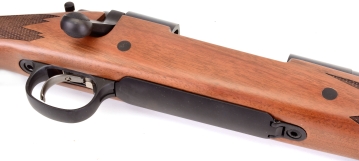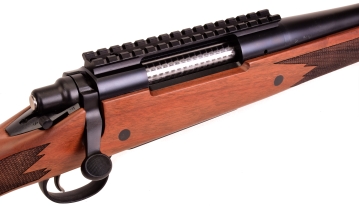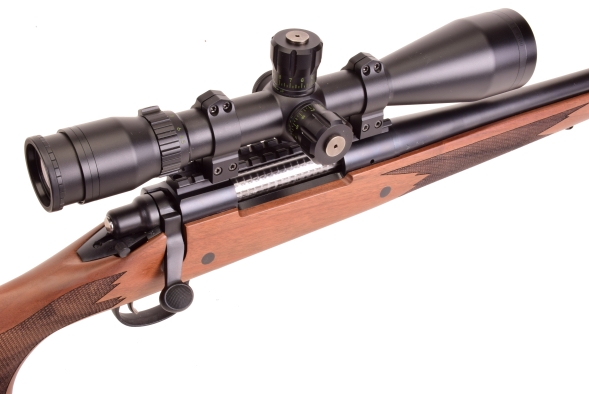 The Remington Model 700, in one version or another, has outsold every other bolt action rifle on the market. In a politics and agenda free world, the Model 700 has stood head and shoulders above all others in sports shooting. The current Model 700 CDL appears to be more of the same with some subtle changes.
The Remington Model 700, in one version or another, has outsold every other bolt action rifle on the market. In a politics and agenda free world, the Model 700 has stood head and shoulders above all others in sports shooting. The current Model 700 CDL appears to be more of the same with some subtle changes.
Wood stocks change periodically. The subject rifle is a moderately dark walnut with tight grain, tastefully accented with matte finished faux ebony forearm tip and grip cap. This generation laser cut checkering has evolved into something that looks good and provides a useful gripping surface

Bottom metal is aluminum; clean, black and unembellished with logos or other forms of mini advertising. It looks very nice and the finish blends well with the rifle’s steel parts. The X-Mark Pro trigger’s pull is crisp, creep free and externally adjustable for pull.
The Model 700 CDL, like all other bolt action Remington rifles, is drilled and tapped for scope mounting systems. In this case, because we mounted several different types and lengths of scopes, a Weaver multi slot aluminum base was installed under the relatively large Bushnell optics. Rings are Warne steel with cross bars that lock the scope in place longitudinally. All of it stayed put under fire.

A couple of comments… because the base is relatively high compared to low profile two piece base set ups, low rings would make for a best fit. In this case the rings are medium height because, for me, it makes shooting off of a bench more comfortable. There is plenty of room under the base as no brass contacted the bottom side on ejection and there is room to single round feed if desired. Everything doesn’t need to be expensive. In this case the base cost was $20.
The Remington Model 700 CDL as a 300 Magnum
|
||||||||||||||||||||||||||||||||||||||||||||
The Remington Model 700 is a well established centerfire and the best selling model over spans of decades. It is known for its inherit strength , accuracy and reliability and for putting food on a hunter’s table.
This particular model offers some specific benefits when chambered for magnum cartridges. As mentioned earlier, the Remington has a long stroke in standard length that easily accommodates the 300 Winchester Magnum cartridge. The 26″ barrel length puts the 300 Winchester Magnum on par with the 300 Weatherby Magnum in terms of velocity.
While not a heavyweight, it is also not an ultra lightweight; 7 lbs 10 oz without scoped and unloaded, 8 lbs 14 oz with large optics installed. There is enough heft to absorb a bit of recoil without making the rifle something heavy to haul around while hunting.
The CDL is a precise shooting rifle, which suits the long range capability of the 300 Winchester Cartridge. The sporter magnum weight barrel holds shot placement when more than three rounds are fired.
The time proven 300 Winchester Magnum
Winchester introduced three cartridges in the mid to late 1950’s and paired them to an application specific theme. The 1956 458 Winchester Magnum was chambered in the Model 70 African for use on big and dangerous game. The 1958 264 Winchester Magnum was chambered in the Model 70 Westerner for wide open space and long shots at deer and antelope and the 338 Winchester Magnum was introduced in the Model 70 Alaskan. A similar 30 caliber cartridge was anticipated to occupy the space between the 338 Win Mag and 264 Win Mag, utilizing the same types of modifications, but that didn’t happen, at least not for 5 years.
Based on the 375 H&H Magnum, shortened to 30-06 Springfield length, shoulders were sharpened and case body taper minimized to maximize powder capacity. The net of the case changes made to the 375 H&H resulted in the 458 Winchester Magnum having the same 95 grain case capacity as the parent 375 H&H case. However, as neck diameters diminish to accommodate smaller calibers, case capacity followed suit; 338 Winchester Magnum 86 grains and 264 Winchester Magnum 82 grains.
|
300 Magnum Contemporaries |
|||||
| Cartridge | Year | A | B | C | Grain |
| 300 Weatherby Magnum | 1948 | 2.445 | 2.825 | 3.560 | 98 |
| 308 Norma Magnum | 1960 | 2.241 | 2.559 | 3.346 | 86 |
| 300 Winchester Magnum | 1963 | 2.356 | 2.620 | 3.340 | 93 |
| 338 Winchester Magnum | 1958 | 2.170 | 2.550 | 3.340 | 86 |
 The 300 Winchester Magnum was a product of push and shove, with both market forces and mechanical constraints at work. Norma had produced a magnum that was virtually the 338 Winchester necked down to accept a 0.308″ bullet and Weatherby had the velocity lead with the flashy 300 Weatherby Magnum. Winchester was challenged to do something more, however, Winchester could not increase maximum length if the 300 Winchester Magnum was to function with a standard length Winchester action.
The 300 Winchester Magnum was a product of push and shove, with both market forces and mechanical constraints at work. Norma had produced a magnum that was virtually the 338 Winchester necked down to accept a 0.308″ bullet and Weatherby had the velocity lead with the flashy 300 Weatherby Magnum. Winchester was challenged to do something more, however, Winchester could not increase maximum length if the 300 Winchester Magnum was to function with a standard length Winchester action.
The 300 Winchester Magnum, near right, was introduced in 1963. Its body is 0.120″ longer than the 338 Winchester, far right, and its neck proportionally shorter which means, depending on where you fall in the half full, half empty spectrum of the universe, it is blessed with 7 grains more powder capacity or cursed with a 0.066″ shorter neck.
The Remington long action has greater stroke and magazine length to accommodate heavy and long ogive bullets… freebore permitting. For the handloader with an OAL gauge, there is overall length latitude to be found.
Does the short neck influence accuracy? Beyond the extensive hunting service the 300 Winchester Magnum has seen, or it win record in 600 to 1000 yard competitive shooting events, it is also commonly utilized for long range military and police tactical assignments. The 300 Winchester, in a good firearm, has proven to be an outstanding cartridge.
 One facet of the 300 Winchester Magnum that makes it more generally useful is modest recoil in a sporting weight rifle, particularly when it is one that weighs more than 8 lbs, scoped and loaded. Additionally, the Remington SuperCell recoil pad really soaks up recoil energy ahead of the shooter’s shoulder. The thump that is left is more than a 30-06 Springfield, much less than a 338 Winchester Magnum. much less than the Remington 300 Ultra Mag, far left, or 300 Weatherby Magnum, center.
One facet of the 300 Winchester Magnum that makes it more generally useful is modest recoil in a sporting weight rifle, particularly when it is one that weighs more than 8 lbs, scoped and loaded. Additionally, the Remington SuperCell recoil pad really soaks up recoil energy ahead of the shooter’s shoulder. The thump that is left is more than a 30-06 Springfield, much less than a 338 Winchester Magnum. much less than the Remington 300 Ultra Mag, far left, or 300 Weatherby Magnum, center.
Thanks to factory ammunition like Hornady’s Superformance 180 grain SST. Rated at 3130 fps, the 26″ barrel Remington Model 700 produced a very consistent 3180 over the chronograph.
| Hornady Superformance 300 Win Mag 180 SST | ||||||
|
Yards |
0 | 100 | 200 | 300 | 400 | 500 |
| Velocity – fps | 3180 | 3004 | 2833 | 2669 | 2511 | 2358 |
| Energy – ft.-lbs. | 4041 | 3605 | 3208 | 2847 | 2519 | 2222 |
| Momentum – lbs-sec | 2.53 | 2.39 | 2.26 | 2.13 | 2.00 | 1.88 |
| Path – in. | -1.5 | 1.4 | 0.4 | -5.0 | -15.2 | -30.9 |
With a 3″ ordinate, the Hornady ammo provides a 246 yard point blank range and it is still maintaining more than 2000 fps and over a ton of energy at 500 yards. Three, 3 shot 100 yard groups shot from the bench measured 1/2″, 3/4″ and 5/8″.
Commenti finali
Remington Model 700 rifles have remained a constant for so long, they always have a comfortable and familiar feel and it takes no time to shoot a new one accurately. This Model 700 CDL was no exception. It felt balanced… solid, went to the shoulder easily and tracked and stopped responsively. I guess it doesn’t hurt that it is a good looking and well made rifle.

Funny, when an all North American combination comes to mind while daydreaming and thinking about lunch, it is always one big bore cannon or another… none based on ballistics or capability, all are an overkill. Working with the Remington and this cartridge, I got to thinking how much ground and over what ranges this combination would fit. Add handloading as an option and you have an extremely flexible 30 caliber. Good rifle, good cartridge, good combination.

Email Notification